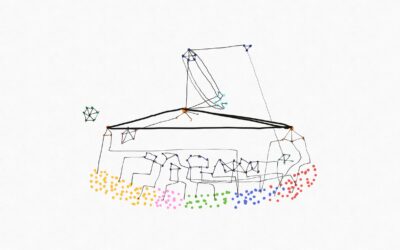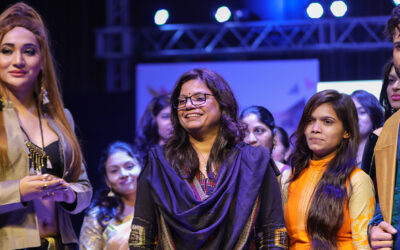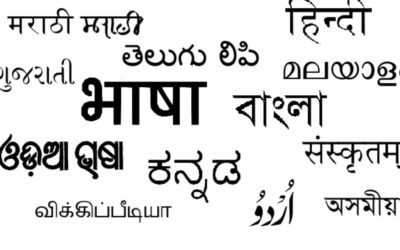The author (left) talking to a Geori* village resident / Source: Manish Kumar
I’d never been quite as excited to hear my alarm blaring at 4.30 AM as I was on 7th December 2021. It was a field visit day. For a fellowship designed to place young Indians at the grassroots of India’s development challenges, a field visit may sound routine enough. This one, though, was worth the excitement–it was the first visit that I got to plan. From the agenda to the location, I held the reins.
So, on that early wintery morning, I was headed to the village of Dehuridih in Jamui, Bihar, to talk to families who migrate out of the village to work at brick kilns. I had been curious about this migration for a while now. When I first came to i-Saksham in October 2021 and began to understand the challenges that affect education in Jamui from various stakeholders, I started making a note in the back of my notebook of the ones that came up frequently. Brick kiln-related migration was one of them.
Children’s names would be written in local government school registers but they’d be conspicuously absent for months at a time because their parents take them along when they migrate seasonally to work in brick kilns. These same children would manage to move up to the next class but lacked foundational literacy and numeracy, and slipped further and further behind.
I’d heard of many different reasons for students’ irregular attendance in my two months here. Some are simpler to understand, like when children travel to their grandparents’ homes when there are back-to-back festivities like Durga Puja, Chhat Puja and Diwali. Some are more complex, like when during dhaan-katni (harvest time), children assist their parents in harvesting paddy or care for younger siblings at home while their parents do agricultural labour.
Understanding a major and extended source of this irregular absence seemed like it would support i-Saksham’s work as it would equip us to deal with a constant challenge we were encountering. In the back of the same notebook, against absenteeism because of migration, I had scribbled (in possible naivety, but most definitely idealism) possible interventions we could design. This included WhatsApp-based audio lessons, take-home teaching-learning materials, working with community learning outside of government schools–if we understood the situation better.
But who was migrating, and when? Where did they go? What was the nature of this labour? What role did children play at a brick kiln? I had innumerable questions, ones that people around me couldn’t fully answer.

Because this kind of research-based field visit was a little bit different from my host organisation’s everyday work and the team was working against the clock on year-end deadlines, I went without a local team member. Our photographer Manish, a consultant who had only a few weeks ago moved to Jamui, also decided to tag along. We started early, took two sharing autos, walked, and finally reached the village as the sun rose and took its place in the sky.
The centre of the village was a small hillock. All around its base were the villagers’ households arranged in tolas or clusters based on caste identity and socio-economic standing. As you moved further outwards, you see acres of farmland. The only contact we had in the village was a young woman, an edu-leader part of i-Saksham’s fellowship. As per our conversation the night before, we went to her and her parents’ house so that she could connect us with some villagers who generally migrate. But the minute we sat down, I saw that she looked confused and apologetic. It went downhill from there.
I quickly realised that Reshma*, the edu-leader, had not understood why we were there. She said yes on the phone because she wanted to be helpful, but she didn’t know who in her village migrated for this work, only knew that some did. We asked her to take us to someone who’d know which families migrate and that we’d take it from there. She then took us into a different tola, slightly up the hillock, where the houses were smaller and more tightly packed together. She told us that some of her lower caste students stayed there.
We found four middle-aged women and an elderly one sitting together outside the doors of their homes, chatting and completing morning chores. Reshma didn’t know them very well either, so I stepped in after a brief introduction and asked if they knew anyone who migrated from this village to work in brick kilns. They looked at each other and became reticent. Dismissing me, they said that nobody from their community worked in brick kilns anymore, and pointed in the direction of a different tola. They were quick to add that we wouldn’t find anyone we can talk to anyway. We decided to part ways with Reshma because she seemed unsure of going to the new tola, this one of Musahar Dalits, and walked in the general direction we were pointed to. This tola was further removed from the other houses we saw in the village and rested on the inclines of one side of the hillock. As we walked, we asked for directions and tried to speak to passersby. People were suspicious and not forthcoming.
At the Musahar tola, there were fewer people out and about, and the houses were further inside kaccha lanes that carved the base of the hillock. Closer to the main village road in that locality, there was a small shop. We could see people coming to buy rations, biscuit packets, toothpaste. So, we decided to try our luck there.
A pattern seemed to repeat itself. People were already sceptical, and as soon as we asked about brick kiln labourers, became even more guarded. They’d sparsely acknowledge that yes, people in this village did migrate out to work in brick kilns, but that we’d find no one to speak to now because they were long gone. Residents were eying us as we walked around, and kept calling out to us, “there is no one there, the houses are locked, you won’t find anyone to speak to” as though we’d barge into strangers’ homes to verify the veracity of their statements. That was not our intention.
We could see, even just from a distance as we walked back around to Reshma’s house, smoke rising from chulahs, clothes hung out to dry, the odd person here or there. The neighbourhood was very quiet, yes, but the houses were not empty–but it was clear we were not wanted.
Finally, Manish and I decided to take a breakfast break at the small temple on top of the hillock and get some photos of the village at least. We climbed up, out of breath because of the layers of winter clothes we were wearing, and sat down on an outcropping of rocks. The view was beautiful, but I was in my own head. I was sorely disappointed and kept trying to figure out what I had done wrong. I didn’t have a grand delusion that I would “crack” the problem in one visit; I knew better than to think of this so reductively. But I had hoped that’d I’d meet one person who’d be willing to talk to me, something that would help kickstart this research. Manish interrupted my silent stewing with some observations about how most of the paddy had already been harvested in the fields we could see. All I could think of was–how could I think about paddy when I just failed?
I had been craving more time on the ground, wanted to prove my mettle, pushed to make this happen, all while holding onto this feeling that this would be the start of something valuable to the community. But I looked up to see what Manish was talking about. The morning sunlight, the village lake, rows of palm trees and yes, quickly emptying fields. Closer to the hillock, I could see the different kinds of houses around the village, peek at the drying chillies set out on balconies, see women hang up clothes to dry or braid their daughters’ hair or feed their goats.

Something shifted. I realised that while I started out wanting to do something valuable for this community, my ego had overridden how I was thinking about this experience. I was centring everything around me. I could not strip people of their agency or demand their openness. In order for people to willingly share their experiences with me, I would have to gain their trust. It was not a given. To think otherwise means to operate from a place of entitlement.
And, as I began to piece together the throwaway information people said and left unsaid, I realised I had learnt many new things that were not just limited to gaining an understanding of brick kiln labourers. It was after this experience, in particular, building on other interactions I’d had with individuals across villages in Jamui, that I got a sense of the general distrust people had of NGOs. Perhaps I was comparing this experience to the one I had in a village in Udaipur, where people didn’t look at you with narrowed eyes if you said you were from a civil society organisation and wanted to ask some questions.
The fact that people were stonewalling us indicated to me that, like the many case studies I’d read about the abysmal working conditions of brick kilns and the illegal labour practises they followed were, in some part, a lived experience of the people here as well. “There is no other work in the village, now even agricultural work can be done by machines,” someone had said. It was clear by the way we were directed to the Musahar tola that the most marginalised, especially on the axis of caste, were the ones who did this work still – “we don’t do this work anymore,” the elderly woman in the SC tola had said, indicating upward mobility.
I also managed to piece together a migration pattern: families left in October – “everyone wants to see the Durga Puja mela,” a man had said cheekily; and came back in May. They travelled within Bihar and across states–while I had seen many kiln chimneys dot the otherwise flat horizon of Jamui, many families went to Punjab, Uttar Pradesh and West Bengal. The shopkeeper we spoke to had told us: “I was speaking to (someone from the village) who was in Bengal yesterday. The sudden rains ruined the bricks they were making, they lost a few days’ earnings.”

And yes, families did migrate together, taking along anyone physically fit and capable of work because a labourer earned not by the number of hours worked but by the number of bricks he or she managed to finish. Young children helped stack bricks into columns, carry raw materials, or even just kept younger siblings out of their parents’ way by feeding and taking care of them. It helped the family maximise their income from this work.

Seeing young girls doing household chores instead of going to school, seeing the way caste segregates space, learning about agricultural cycles–everything I was able to gauge from being on the field was building a base of knowledge that was helping me see even the problems of education so much more clearly. The gendered aspect of accessing education, why some of our edu-leaders initially hesitate to work in certain schools because they cater to children from a lower caste tola, mapping children’s absenteeism to the work that is happening in the fields. I craved fieldwork because it opened my eyes, every single time, only if I kept myself open to that learning.
As I headed back out to look for an auto to take us back to Jamui, I realised that this visit hadn’t squashed my interest. It left me more curious. Obviously, I had made mistakes, but this also highlighted for me just how much skill it takes to successfully engage with community.
These were the skills that I wanted to learn, a core reason for seeking out this fellowship. I still want to do what I set out to do, but now with more questions, a greater attunement to the complexity of the context and a desire to practice more humility.
* Names changed to protect identity




0 Comments